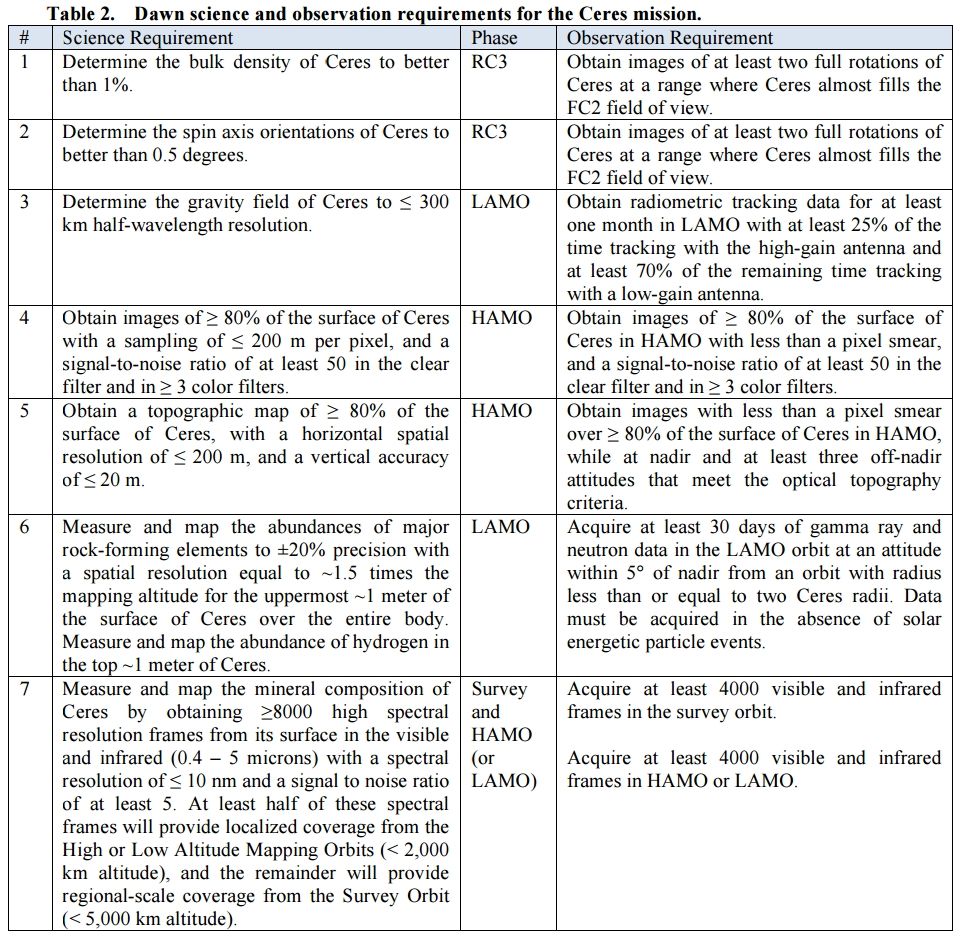See also http://arc.aiaa.org/doi/pdf/10.2514/6.2016-2442 which sumarises the first three months of Dawn in final science orbit around Ceres.
The Dawn mission at Ceres was originally scheduled to end June 30, 2016. Wikipedia has an update on that: “On April 20, 2016, New Scientist announced that the Dawn team had sent NASA a proposal for an extended mission. According to the report, the spacecraft retains enough xenon fuel to break Ceres orbit and reach a third asteroid. In July 2016, NASA rejected the proposal. The Dawn spacecraft is expected to operate at Ceres until 2017. … and become a permanent satellite of Ceres”.
Table 2 from above link.

Gravity Science Performance
Prior to Ceres arrival, the gravity science team estimated that one month of LAMO operations was necessary to meet the science requirement. It was important to acquire this month of tracking prior to February and March 2016, when the Sun-Earth-probe angle meant that gravity science data quality would be compromised. Fortunately, Ceres arrival was earlier than had been predicted and there were few spacecraft anomalies at Ceres so LAMO started early. This provided six weeks of LAMO gravity science prior to the period of low Sun-Earth-probe angle. The data acquired have enabled determination of the gravity field to degree 5 with sufficient accuracy.
Gamma Ray and Neutron Detector (GRaND) Performance
The current orbit completes one longitude repeat cycle in 93 orbits over 21 days. Modeling of GRaND’s response to Ceres’ expected composition indicated that two cycles would suffice. Four cycles provides complete functional redundancy. The data was minimally impacted by solar activity. Moderate correctable variations in the galactic cosmic ray background were observed in the neutron data.
Lessons Learned
The Dawn Ceres mission has reinforced some of the lessons already learned by the Vesta mission. Both missions benefited from the policy of planning redundant observations to allow for graceful recovery from data loss. There were multiple instrument anomalies at both Vesta and Ceres that lost significant portions of planned data acquisition.
A challenge unique to Ceres was the decision to deviate from the methodical mapping campaign to acquire data from targets of interest. Occator crater on Ceres presented an unexpected challenge. The albedo of the bright region within Occator was so high that some areas were saturated in the images
acquired with exposures appropriate to the average Ceres surface. The science operations
team scheduled double imaging any time the bright spots were observed. Adding these extra images only to selected orbits violated the standard orbit templates, but the team was able to accommodate the late changes. The greater challenge was predicting which orbits would fly over Occator. This prediction worked well until LAMO when orbit perturbations became more significant.
The lessons learned by Dawn are now being applied to a future solar electric propulsion Discovery mission proposal to orbit the iron-nickel asteroid 16 Psyche.
—-
Note that no spacecraft has so far photographed any asteroid containing large quantities of metal. This should be interesting. For more on this new mission, see https://en.wikipedia.org/wiki/Psyche_
Proposed mission launch, 2020 to arrive in orbit in 2026. “Psyche was selected on 30 September 2015 as one of five semifinalists for the Mission #13 of the Discovery Program. The winner will be chosen around September 2016.”
Science objectives of Psyche
. Is asteroid 16 Psyche the stripped core of a differentiated planetesimal, or was it formed as an iron-rich body? What were the building blocks of planets? Did planetesimals that formed close to the Sun have very different bulk compositions?
. If 16 Psyche was stripped of its mantle, when and how did that occur?
. If 16 Psyche was once molten, did it solidify from the inside out, or the outside in?
. Did 16 Psyche produce a magnetic dynamo as it cooled?
. What are the major alloy elements that coexist in the iron metal of the core?
. What are the key characteristics of the geologic surface and global topography? Does 16 Psyche look radically different from known stony and icy bodies?
. How do craters on a metal body differ from those in rock or ice?
The other 4 finalists for Discovery Mission #13 are:
1) Deep Atmosphere Venus Investigation of Noble gases, Chemistry, and Imaging (DAVINCI) − it would study the chemical composition of Venus’ atmosphere during a 63-minute descent.
2) Venus Emissivity, Radio Science, InSAR, Topography, and Spectroscopy (VERITAS) — it would produce global, high resolution topography and imaging of Venus’ surface and global surface composition.
3) Near Earth Object Camera (NEOCam) — is a space infrared telescope designed to survey the Solar System for potentially hazardous asteroids.
4) Lucy — it would perform the first reconnaissance of the Jupiter trojan asteroids.
Which of the five would you choose?

